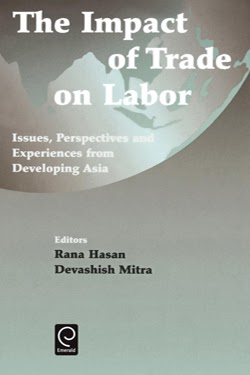The Impact of Trade on Labor: Issues, Perspectives and Experience from Developing Asia
Devashish Mitra
Emerald Group Publishing, December 2003

Proponents of free trade routinely argue that an important benefit for developing countries is that it provides significant economic opportunities for their asset-less workers. By now, virtually all developing countries, have moved towards integrating themselves more closely with the international economy. To what extent have workers actually benefited from this integration?
"The Impact of Trade on Labor" attempts to piece together broad-based evidence on the effects of trade liberalization on labor markets in developing countries in general, and selected countries from developing Asia in particular. The analysis of the available evidence takes into account the recent theoretical advances in this area. The volume consists of nine substantive chapters separated into two parts. A main contribution of the first part is to use a blend of both theory and empirics to point out that the impact of trade liberalization on labor markets, including adjustment costs, depends in important ways on domestic labor market regulations and the nature of competition or market structure.
Part I of the volume also presents a detailed discussion on the issue of labor standards, including whether trade access should be linked to a country's labor standards. The second part of the volume moves on to a consideration of various related issues in three large and labor intensive countries, China, India and Indonesia.
The approach taken in these studies is to focus on a specific issue of interest and examine this issue carefully for one country using available data. Thus the chapter on China examines the linkages between foreign direct investment and domestic labor standards; the Indonesia chapter assesses the relationship between trade and wage inequality between skilled and unskilled workers; and the chapter on India focuses more broadly on how trade liberalization has impacted employment in the manufacturing sector, paying special attention to the issue of labor market regulations.